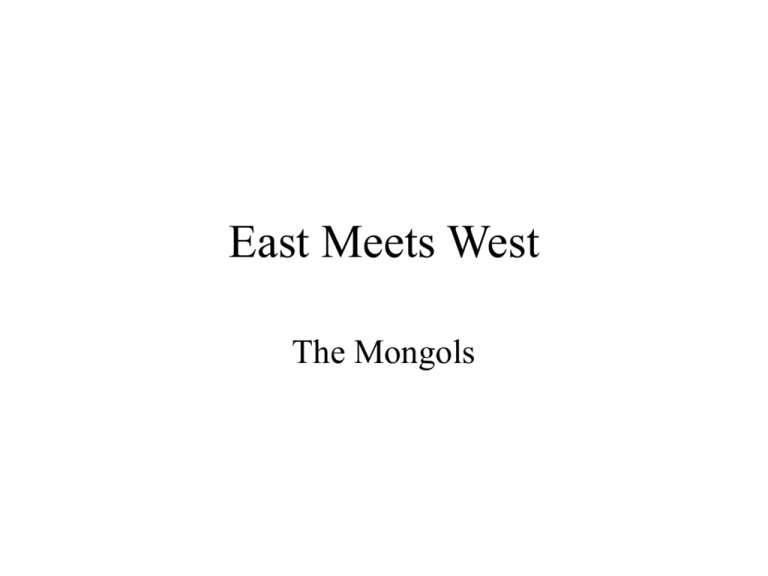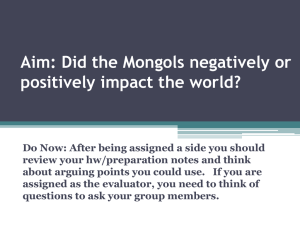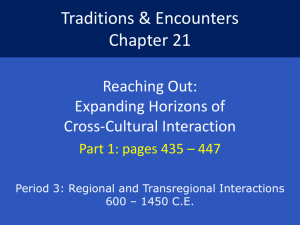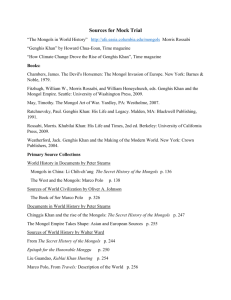East Meets West
advertisement

East Meets West The Mongols Temuchin's Rise Born ca. 1162, d. 1227 After long period of tribal conflict and intrigue, succeeded in unprecedented feat of unifying all Mongols. Declared Khan of Khans and given name Genghis Khan, 1206. Conquest of North (Kin) China 1211-1214 War with Persia 1218-1222 War started after Persians put Mongol emissaries to death. War of annihilation on both sides. Mongol detachment sent to pursue Shah across his own empire. Following conquest of Persia, Mongol troop circled Caspian. The Legend of Prester John • A Christian King David ruled a great land in the East • His son, Prester John, would come and rescue Europe from the Islamic threat • Many Mongols were technically Christians of the Nestorian sect Rumors of Mongol attack on Moslems reinforces belief in the legend Mongol Battle Tactics • • • • • • Constant practice in riding, archery. Travelled very light. Extraordinary endurance. Extremely ruthless in battle. Extraordinary military discipline. Practical, readily assimilated advanced siege technology. Mongol Battle Tactics Remarkable ability to coordinate armies separated by great distances. Mobility unheard of by armies of the time-up to 100 miles/day. Mongol combination of mobility and communication probably not equaled again until W.W. II. Rule in conquered territories Ruthless annihilation of resistance (terror tactics). General benevolence when no resistance. Cities generally left under native governors. Religious tolerance important in consolidating rule, gain support of minorities oppressed by Moslems. • Administration commonly more benign, less corrupt than pre-Mongol government. Positive qualities of Mongols Discipline, obedience to own laws Sense of honor and loyalty, respect for these qualities in others, even opponents High status of women • These qualities attested even by European observers who generally detested the Mongols Genghis Khan’s Value Statement “The greatest joy a man can know is to conquer his enemies and drive them before him. To ride their horses and take away their possessions. To see the faces of those who were dear to them bedewed with tears, and to clasp their wives and daughters in his arms.” After Genghis Khan • Empire splits into three functionally independent realms: – China and Mongolia – Russia – Persia • In principle the rulers of Russia and Persia were regents for the Khan in China Mongols in Europe • Mongols conquer Russia, 1236-1242 • A nomadic tribe, the Kumans, asked king of Hungary for asylum • Mongols attack Hungary, 1241, when king refuses to relinquish the Kumans • Within three months, Mongols obliterate all military resistance in Eastern Europe • Mongols break off attack when Khan dies, never return Mongols in the Middle East • Mongol-ruled Persia goes to war against the Caliph • Mongols capture, sack, obliterate Baghdad, 1258 • Canal system of Iraq destroyed • Psychological blow from which Islam never recovered • Egypt saved by battle of Ayn Jalut, 1259; Mongols fight Mongols for first time Mongols in China • • • • Raid North China 1211 - 1214 Full conquest of North China 1225-1230 Final Conquest of South China 1269 - 1279 Failed invasions and Expeditions to: – – – – Vietnam Burma Indonesia Japan Mongols in Japan • Invasions in 1279 and 1281 • Mongols unable to advance beyond beachheads • Japanese unable to drive invaders out • Both times, a typhoon wrecked the invasion fleet • Led to Japanese notion of the “Divine Wind” - Kamikaze Trans-Eurasian Contact • First European accounts by John of Piano Carpini (1240’s) and William of Rubruck (1250’s) • Marco Polo 1271-1291 • By early 1300’s, over two dozen diplomatic missions from Europe to China • Francesco Pegolotti, La Practica della Mercatura, 1340 • Mongol rule in China ends, 1368









